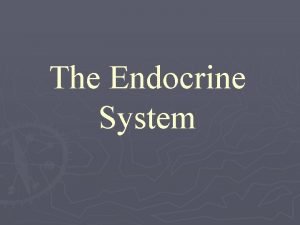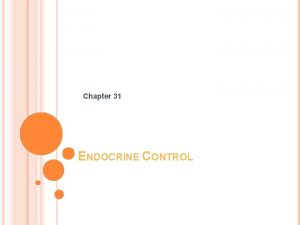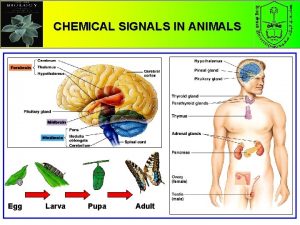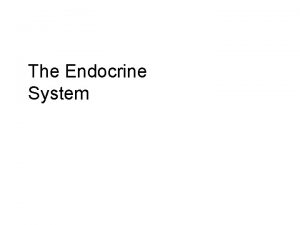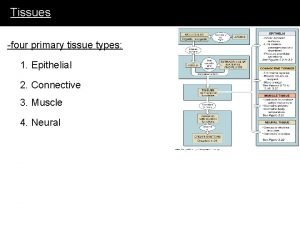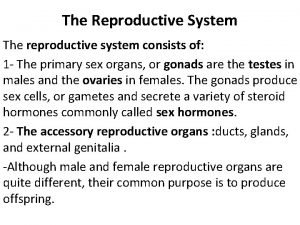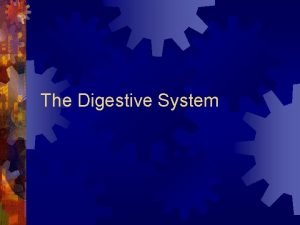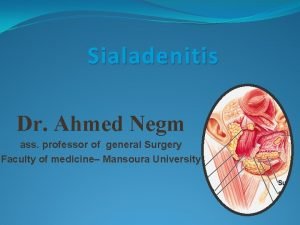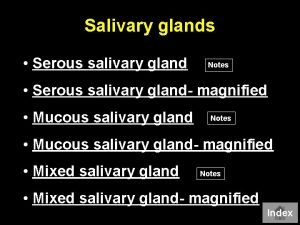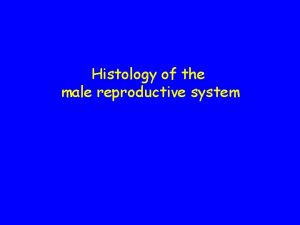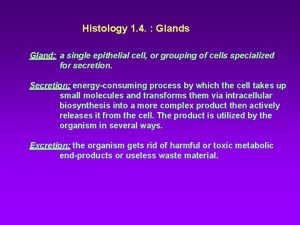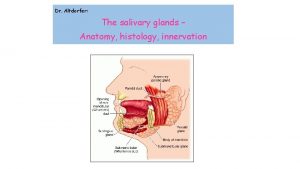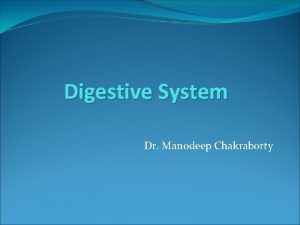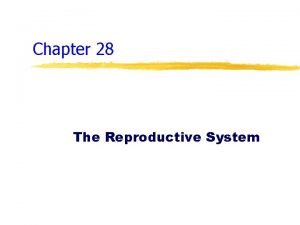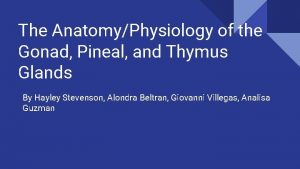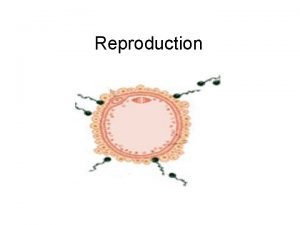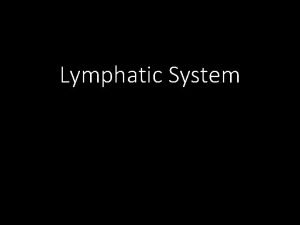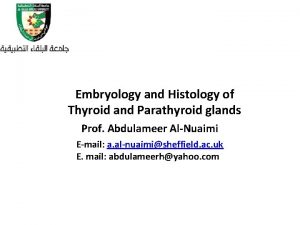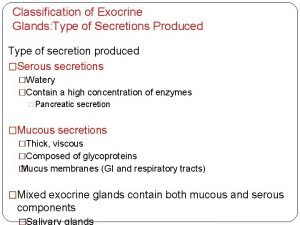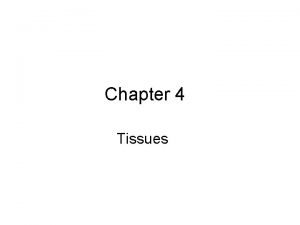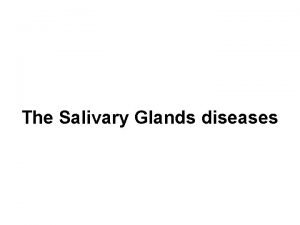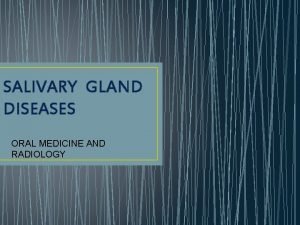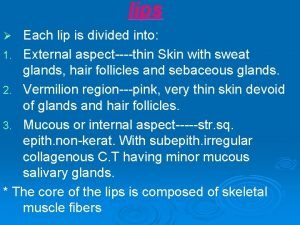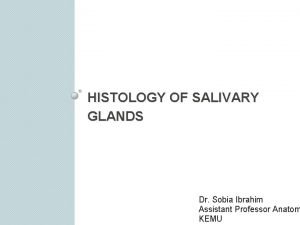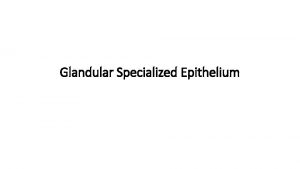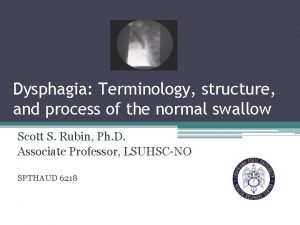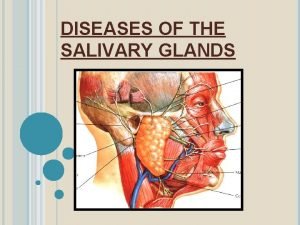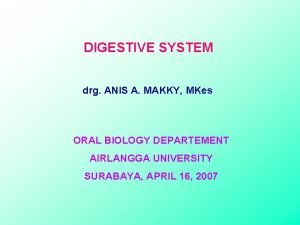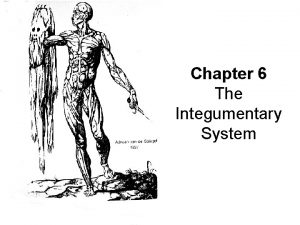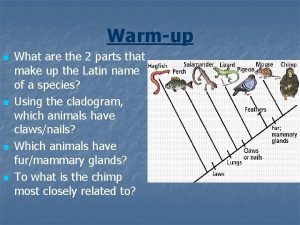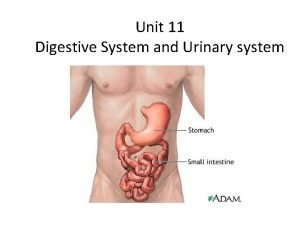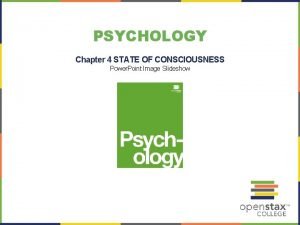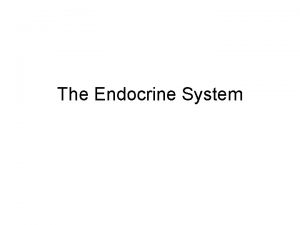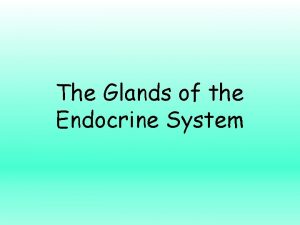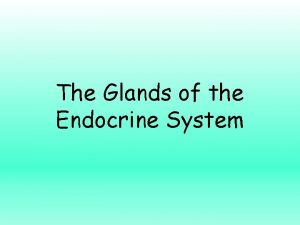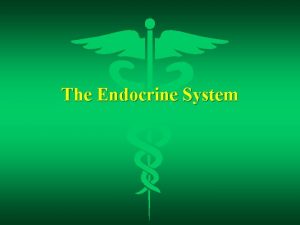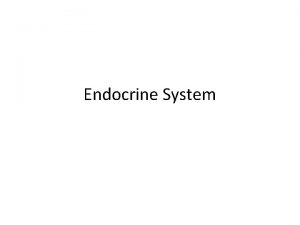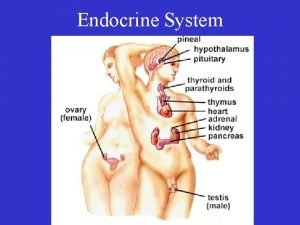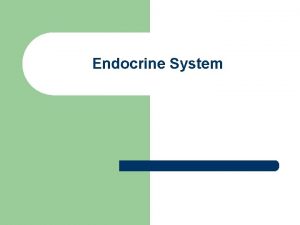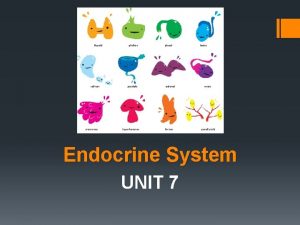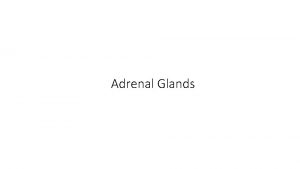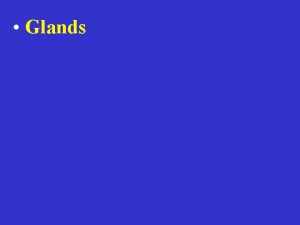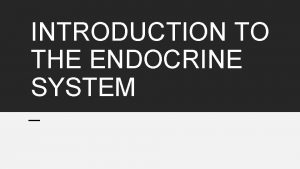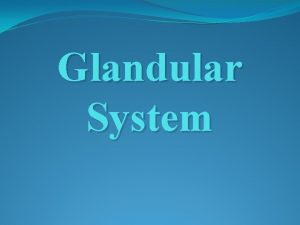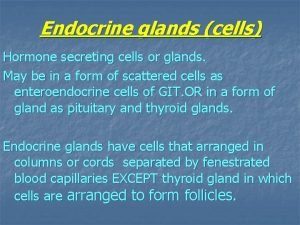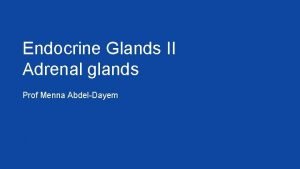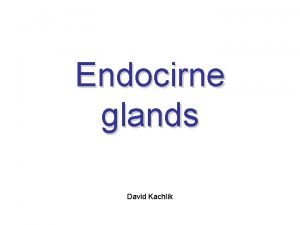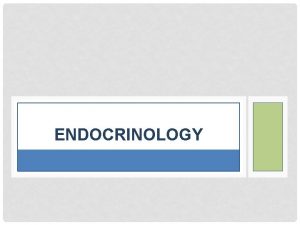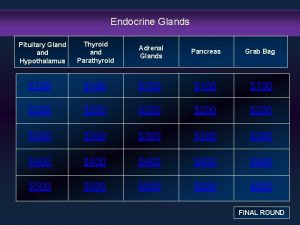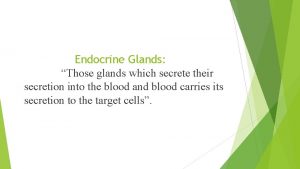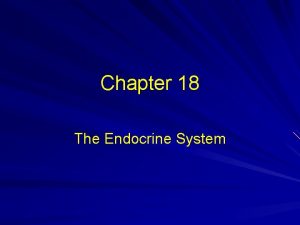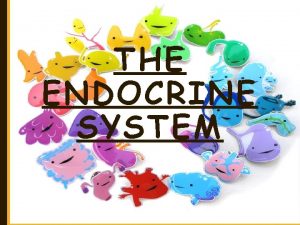Endocrine System 1 Endocrine Glands The endocrine system





























































- Slides: 61

Endocrine System 1

Endocrine Glands The endocrine system is made of glands and tissues that secrete hormones. Endocrine glands are ductless organs, producing their chemical messengers (hormones) and secreting them directly into the bloodstream, whereas other glands (exocrine glands) produce their chemicals and excrete them into a duct (ex. digestive enzymes, sweat). 2

Hormones are chemicals that influence metabolism of cells, the growth and development of body parts, and homeostasis. Hormones can be classified as protein or steroids. 3

There is a close association between the endocrine and nervous systems. Hormone secretion is usually controlled by either negative feedback or antagonistic hormones that oppose each other’s actions, and results in maintenance of a bodily substance or function within normal limits. 4

The endocrine system 5

Chemical Signals A chemical signal is any substance that affects cell metabolism or behavior of the individual. Chemical signals can be used between body parts, between cells, and between individual organisms (pheromones). Underarm secretions may be slightly attractive and may be involved in synchronizing the menstrual cycles of women who live together. 6

Chemical signals 7

Chemical signals 8

The Action of Hormones Steroid hormones enter the nucleus and combine with a receptor protein, and the hormone-receptor complex attaches to DNA and activates certain genes. Transcription and translation lead to protein synthesis. 9

Action of a steroid hormone 10

Hormones trigger changes in their target cells when they bind to receptor proteins on or within the cells. A model of a hormone (A) bound to its protein receptor (B). Each hormone of the endocrine system has a unique molecular shape, which fits into a specific receptor protein on its target cells. 11

Peptide hormones are usually received by a hormone receptor protein located in the plasma membrane. Most often the reception of a peptide hormone leads to activation of an enzyme that changes ATP to cyclic AMP (c. AMP). c. AMP, as a second messenger, then activates an enzyme cascade. Hormones work in small quantities because their effect is amplified by enzymes. 12

Action of a peptide hormone 13

• Hormone production will be regulated in most cases by negative feedback systems. Once the desired outcome is reached, the outcome will inhibit the hormone release. • Hormones are also classified as: – Tropic: have endocrine glands as their target – Non-tropic: don’t have endocrine glands as their target 14

The endocrine system 15

Hypothalamus and Pituitary Gland The hypothalamus regulates the internal environment through the autonomic system and also controls the secretions of the pituitary gland. The pituitary has two portions: the anterior pituitary and the posterior pituitary. 16

Posterior Pituitary The posterior pituitary stores and releases the antidiuretic hormone (ADH) and oxytocin produced by the hypothalamus. ADH is secreted during dehydration and causes more water to be reabsorbed by the kidneys; the secretion of ADH is regulated by negative feedback. Oxytocin causes uterine contractions and milk release, and is controlled by positive feedback. 17

Posterior Pituitary ADH is released when the blood plasma concentration is high (and blood pressure is low). ADH stimulates the kidneys to absorb more water, which dilutes the blood plasma (and increases blood pressure). 18

Anterior Pituitary The hypothalamus controls the anterior pituitary by producing hypothalamicreleasing hormones and hypothalamicinhibiting hormones. The anterior pituitary produces six hormones. Four of these six hormones have an effect on other endocrine glands: 1) Thyroid-stimulating hormone (TSH) stimulates the thyroid to produce thyroid hormones; 19

2) adrenocorticotropic hormone (ACTH) stimulates the adrenal cortex to produce cortisol; 3&4) the gonadotropic hormones (FSH and LH) stimulate the gonads to produce sex cells and hormones. In these three instances, the blood level of the last hormone exerts negative feedback control over the secretion of the first two hormones. 20

21

The next three anterior pituitary hormones do not effect other endocrine glands. After childbirth, prolactin (PRL) causes mammary glands to produce milk. Growth hormone (GH) promotes skeletal and muscular growth. 22

Hypothalamus and the pituitary 23

Effects of Growth Hormone The quantity of GH is greatest during childhood and adolescence; GH promotes bone and muscle growth. Pituitary dwarfism results from too little GH during childhood. Giants result from too much growth hormone during childhood. If growth hormone is overproduced in an adult, it causes acromegaly. 24

Effect of growth hormone 25

Acromegaly 26

Thyroid and Parathyroid Glands The thyroid gland is a large gland located in the neck, where it is attached to the trachea just below the larynx. The four parathyroid glands are embedded in the posterior surface of the thyroid gland. 27

Thyroid Gland The thyroid gland requires iodine to produce thyroxine (T 4) which contains four iodine atoms, and triiodothyronine (T 3) which contains three iodine atoms. Thyroid hormones increase the metabolic rate, and stimulate all body cells to metabolize and use energy at a faster rate. 28

Effects of Thyroid Hormones If iodine is lacking in the diet, a simple goiter develops. Use of iodized salt helps prevent simple goiters. Hypothyroidism in childhood produces cretinism; in adulthood it causes myxedema. If the thyroid is overactive (Grave’s disease) an exophthalmic goiter develops. 29

• if too much thyroxine is present hyperthyroidism (Grave’s disease) – jittery, weight loss, fast heart rate, feel warm, mood swings, hair loss, bulging eyes – treated by removing a portion of the thyroid gland (surgically or chemically) • if too little thyroxine is present hypothyroidism – cold, fatigue, dry skin, hair loss, weight gain, sleep a lot (myxedema in adults) – in children, leads to abnormal mental and physical development , growth retardation (cretinism in childhood) 30

• if too little iodine in the diet thyroid swells (goiter) • iodine is required to synthesize thyroxine • swelling is due to the continued stimulation by TSH (no thyroxine made), causes increase in thyroid size in an attempt to make more thyroxine 31

Simple goiter 32

Cretinism 33

Calcitonin The thyroid gland also produces calcitonin, which helps lower the blood calcium level when it is too high. The primary effect of calcitonin is to bring about the deposit of calcium in the bones; it does this by temporarily reducing the activity and number of osteoclasts. When the blood level of calcium is returned to normal, the release of calcitonin is inhibited. 34

Parathyroid Glands Parathyroid glands secrete parathyroid hormone (PTH), which raises the blood calcium when it is insufficient, and decreases the blood phosphate level. PTH acts by stimulating the activity of osteoclasts, thus releasing calcium from bone, and stimulates the reabsorption of calcium by the kidneys and intestine. Insufficient parathyroid hormone will cause serious loss of blood calcium and cause tetany. 35

Regulation of blood calcium level 36

Adrenal Glands Adrenal glands sit atop the kidneys and have an inner adrenal medulla and an outer adrenal cortex. The hypothalamus uses ACTH-releasing hormone to control the anterior pituitary’s secretion of ACTH that stimulates the adrenal cortex. The hypothalamus regulates the medulla by direct nerve impulses. 37

The adrenal medulla secretes epinephrine and norepinephrine, which bring about responses we associate with emergency situations. On a long-term basis, the adrenal cortex produces glucocorticoids similar to cortisone and mineralocorticoids to regulate salt and water balance. The adrenal cortex also secretes both male and female sex hormones in both sexes. 38

Adrenal glands 39

Glucocorticoids Cortisol promotes breakdown of muscle proteins to amino acids; the liver then breaks the amino acids into glucose. Cortisol also promotes metabolism of fatty acids rather than carbohydrates, which spares glucose. Both actions raise the blood glucose level. High levels of blood glucocorticoids can suppress immune system function. 40

Mineralocorticoids Aldosterone causes the kidneys to reabsorb sodium ions (Na+) and excrete potassium ions (K+). When blood sodium levels and blood pressure are low, the kidneys secrete renin; the effect of the renin-angiotensinaldosterone system is to raise blood pressure. 41

Regulation of blood pressure and volume 42

Malfunction of the Adrenal Cortex Addison disease develops when the adrenal cortex hyposecretes hormones. A bronzing of the skin follows low levels of cortisol, and mild infection can lead to death; aldosterone is also hyposecreted, and dehydration can result. Cushing syndrome develops when the adrenal cortex hypersecretes cortisol. The trunk and face become round; too much aldosterone results in fluid retention. 43

Addison disease 44

Cushing syndrome 45

Pancreas The pancreas is between the kidneys and the duodenum and provides digestive juices and endocrine functions. Pancreatic Islets of Langerhans secrete: - insulin, from the beta cells, which lowers the blood glucose level - insulin makes cells more permeable to glucose - glucagon, from the alpha cells, which increases the blood glucose level - glucagon causes the conversion of glycogen to glucose 46

Regulation of blood glucose level 47

Diabetes Mellitus The most common illness due to hormonal imbalance is diabetes mellitus. Diabetes is due to the failure of the pancreas to produce insulin or the inability of the body cells to take it up. Hyperglycemia symptoms develop, and glucose appears in the urine. Diabetes is diagnosed using a glucose tolerance test. 48

Glucose tolerance test 49

Type I diabetes mellitus occurs when the pancreas does not produce insulin and the patient requires insulin injections. Most people with diabetes have Type II diabetes mellitus where the pancreas produces insulin but the body cells do not respond. Both types lead to long-term serious complications. 50

• type I (insulin dependent) caused by lack of insulin production in pancreas, hereditary but may skip generations • treated with insulin injections and rigid blood monitoring • since insulin is a protein it would be digested if taken orally • must monitor both hypoglycemia (need glucagon or glucose) and hyperglycemia (need insulin) • in research: islet transplants, gene therapy (thought to have found gene) 51

• type II (insulin independent), caused by decreased insulin production, or too much glucose produced by the liver (not enough compensation by pancreas), insulin resistance • gestational diabetes, during pregnancy, mother develops symptoms – at a greater risk for type II later in life 52

• only type I requires daily insulin injections, type II and GDM are treated by changing diet & sometimes sulfonamides • symptoms of type I and II – fatigue (not enough glucose inside cells to provide an energy source – must use fat & protein) – excessive thirst & urination (glucose in urine pulls out water by osmosis) – increased appetite (& weight loss – type I) – increased susceptibility to infection • *** in type II, since it onsets slowly, there may be no symptoms initially • diabetes causes many complications due to fluctuations in blood sugar and ketoacidosis (products of fat breakdown which are toxic to the body), leads to acetone smell on the breath 53

• diabetes insipidous, which has nothing to do with insulin, but ADH production in the pituitary – a tumour or injury causes ADH or response to ADH, causing frequent urination (up to 30 L per day). Treat with ADH nasal spray 54

Other Endocrine Glands Testes and Ovaries Testes, located in the scrotum, produce the male hormone testosterone. Ovaries in the female produce estrogens and progesterone. Secretions from the gonads are controlled by the anterior pituitary hormones. These sex hormones maintain the sex organs and secondary sex characteristics. 55

The effects of anabolic steroid use 56

Prostaglandins are produced within cells from arachidonate, a fatty acid. Prostaglandins act close to where they are produced. They cause uterine muscle contraction and are involved in the pain of menstrual cramps; aspirin is effective against the pain by countering prostaglandins. 57

Chapter Summary Hormones are chemical signals that affect the activity of target glands or tissues. Endocrine glands are ductless and distribute hormones by the bloodstream. The hypothalamus is a part of the brain that controls the functioning of the pituitary gland. 58

The anterior pituitary produces several hormones, some of which control other endocrine glands. Growth hormone is produced by the anterior pituitary; giants are due to overproduction of growth hormone during childhood, and pituitary dwarfs are due to underproduction of growth hormone. The thyroid produces two hormones that speed metabolism and another hormone that lowers the blood calcium level. 59

The distinct parathyroid glands produce a hormone that raises blood calcium level. Adrenal glands produce hormones that help us respond to stress. Malfunction of the adrenal cortex leads to the symptoms of Addison disease and Cushing disease. The pancreas secretes hormones that regulate the blood glucose level. 60

Diabetes mellitus occurs when cells are unable to take up glucose and it spills over into the urine. The gonads produce sex hormones that control secondary sex characteristics. Many other tissues, although not traditionally considered endocrine glands, secrete hormones. Hormones influence the metabolism of their target cells. 61
 Pseudostratified columnar
Pseudostratified columnar Endocrine glands
Endocrine glands Major endocrine glands male and female
Major endocrine glands male and female Chapter 16 matching questions 1-5
Chapter 16 matching questions 1-5 Difference between endocrine and exocrine glands
Difference between endocrine and exocrine glands Exocrine glands are ductless
Exocrine glands are ductless Pathology
Pathology Whats the difference between endocrine and exocrine glands
Whats the difference between endocrine and exocrine glands Endocrine glands
Endocrine glands Endocrine glands
Endocrine glands What are chemical signals
What are chemical signals Endocrine system
Endocrine system Hyophysis
Hyophysis Rat external anatomy
Rat external anatomy Glands in integumentary system
Glands in integumentary system Endocrine system and reproductive system
Endocrine system and reproductive system Endocrine system and nervous system
Endocrine system and nervous system Lympathic
Lympathic Endocrine vs nervous system venn diagram
Endocrine vs nervous system venn diagram Endocrine system
Endocrine system Four primary tissue types
Four primary tissue types Female reproductive system definition
Female reproductive system definition Intestinal glands
Intestinal glands Where are the gastric glands located
Where are the gastric glands located Types of salivary glands
Types of salivary glands Difference between serous and mucous acini
Difference between serous and mucous acini Nie wiem association
Nie wiem association Propolis block factories
Propolis block factories Spermatocytogenesis
Spermatocytogenesis Coiled gland
Coiled gland Submandibular gland
Submandibular gland Types of salivary glands
Types of salivary glands Posterior view of the female reproductive organs
Posterior view of the female reproductive organs Sebaceous glands function
Sebaceous glands function It has fur and mammary glands
It has fur and mammary glands Thyroid belly shape
Thyroid belly shape What are gonads
What are gonads Stomach layers histology
Stomach layers histology From where sperm is produced
From where sperm is produced The purified lymph with lymphocytes and antibodies added
The purified lymph with lymphocytes and antibodies added Steroids endocrine system
Steroids endocrine system Site:slidetodoc.com
Site:slidetodoc.com Histological structure of parathyroid gland
Histological structure of parathyroid gland Appendices omentales
Appendices omentales Classification of exocrine glands
Classification of exocrine glands Merocrine gland
Merocrine gland Cardiac muscle striations
Cardiac muscle striations Submandibular gland excision
Submandibular gland excision Chemical digestion
Chemical digestion Sialography
Sialography Colon
Colon Gruczoł
Gruczoł Cytocrine glands
Cytocrine glands Dysphagia terminology
Dysphagia terminology Minor salivary glands
Minor salivary glands Minor salivary glands
Minor salivary glands Flask shaped gland
Flask shaped gland Dolphin mammary glands
Dolphin mammary glands Do bullfrogs have mammary glands
Do bullfrogs have mammary glands Gross anatomy of the gallbladder pancreas and bile passages
Gross anatomy of the gallbladder pancreas and bile passages Mammary gland merocrine
Mammary gland merocrine Cl channel
Cl channel


